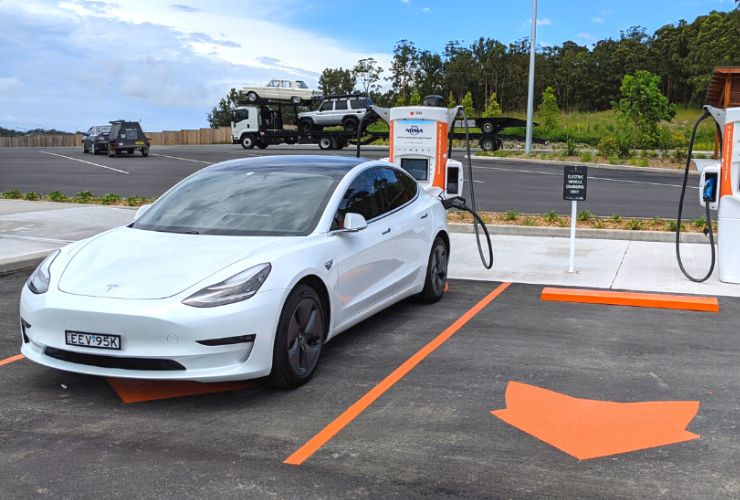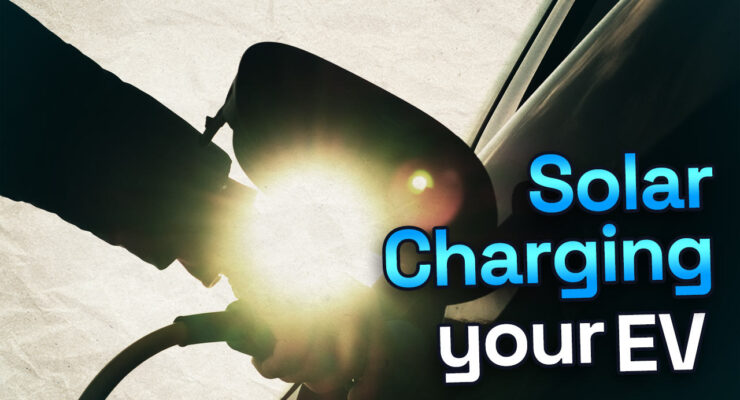Fast read
As the prices come down and choices increase, many Australians are switching to electric vehicles (EVs) to save money and decrease emissions. One way to save even more money and reduce emissions further is by charging an EV with solar power.
However, the question remains on how many panels are needed to fully charge an EV and if possible. The average consumption to charge the car for a Tesla Model 3. Which uses about 12kWh per 100km, which is about 2,500 kWh per year if we travel approx 20,000km. This electricity will cost around $900 if we take the electricity straight from our PowerPoint.
For example, if we use solar to generate 2,500 kWh of electricity in Melbourne, we would need 2kW of solar. So on a 400W panel size, this would be five modern solar panels.
I have an EV and want to charge it with solar panels
Many Australians are deciding to ditch the fuel-guzzling combustion vehicle for an electric vehicle to lower their costs and emissions when getting from one place to another. The next step is charging an EV with solar panels, bypassing the public charging queues. As well as save even more money and decrease your overall carbon footprint.
However, the question now is how many panels exactly do you need to charge an electric vehicle fully, and is it even possible to fully charge your EV from solar?
In the past, gas prices controlled vehicle owners, limiting their ability to decide when and where they drove. This is not the case with electric vehicles (EVs), as owners now have control over their vehicle’s fuel price.
Furthermore, by incorporating solar panels to charge your EV, you are given an environmentally more friendly and cheaper option for fuel, rather than using a public charger or energy from the grid.
How much will it cost me to charge my EV a year?
So how much would it cost you? Below is a table that looks at the price of charging a Tesla Model 3 with solar, public charging and grid electricity on average.
| Method of Charging | Solar(FIT value) | Grid Energy | Public Charging |
| Fuel in a year | 2,500 kWh | 2,500 kWh | 2,500 kWh |
| Cost of fuel | $0.08 per kWh | $0.35 per kWh | $0.50 per kWh |
| Yearly Cost | $200 | $875 | $1,250 |
Of course, these numbers will vary with the amount of driving an owner does as well as the model of the car. However, these figures give you a good indication.

How far will I get with 1 kWh of charge?
This is a highly open question and depends on your EV. However, similarities are seen in petrol cars, where a 2022 Toyota Camry will have better fuel efficiency than a 1968 Ford Mustang. Regarding popular EVs on the market right now, refer to the table below to see how far each EV will be able to get you with 1kW of charge.
- Tesla Model 3: 9 kilometres
- Chevrolet Bolt: 6.4 kilometres
- Mitsubishi i-MiEV: 6.3 kilometres
- 2016 Nissan Leaf: 5.7 kilometres, with newer models getting better efficiency.
- Tesla S sports car: 5.3 kilometres
How many solar panels will this require?
So now that you know how much it will cost and, on average, how much power your EV would need per year to be fully charged, how many panels would this equate to?
You need three main data points to work out how many solar panels you would need to fully charge your EV. These are;
- Electric vehicle energy consumption per year;
- The wattage of your current or planned solar panels;
- What is the efficiency of solar panels in your location?
As stated above, the average energy usage of 20,000km for a Tesla Model 3 is 2,500 kWh per year. The most common panel wattage offered in Australia in 2023 ranges from 390 to 450 watts, so let’s say one gets a 400-watt panel for this exercise.
Finally, the power output of solar panels in Australia is usually substantially higher than in other countries, given our abundant sunlight.
Calculations
If we put all these data points together and do a few calculations, for example, for Melbourne, one would need a 2kW solar system to generate enough electricity to charge the Tesla 3. 2kW are 2000 Watts, so 5 x 400W solar panels would be sufficient.
However, these panels would have to have all their produced power going directly to charging the EV. No other appliances exist, and the solar array would have to generate the power exactly when the car would need charging. Therefore, to be safe, one would double the solar system size to 4 kW to have the solar confidentially charge the car when needed, meaning we are looking at 4kW of solar and 10 solar panels.
In the future, will there be any benefits for me?
In the future, energy retailers may start offering various plans specifically for charging your EV. For example, when preparing this FAQ, AGL has a special offer that allows electric cars to be charged $1 a day. Potentially in the future, we can see more deals like this by other energy providers.

Slow charging may be beneficial to your EV
Depending on your car’s charging method, you may save money using a slower charge. This is because of the variable output of a solar system. A solar system’s production varies constantly, depending on clouds and weather patterns.
If your PV system produces 3kWh at 11 am and your home uses 0.5kWh, you can use your home’s level 1 charger to charge the remaining 2.5kWh.
Alternatively, if you use your home’s level 2 charger, which needs 3kWh, but only 2.5kWh is available from solar, the grid must cover the remaining 0.5kWh for EV charging. The efficiency of your car’s charging method may be influenced by the speed of the charge and how it aligns with your solar system’s variable output. A solar panel system’s production fluctuates based on factors like clouds and weather patterns.
For instance, if your PV system generates 3kWh at 11 am, and your home consumes 0.5kWh, you can utilise your home’s level 1 charger to make use of the remaining 2.5kWh for EV charging.
On the other hand, if you opt for your home’s level 2 charger, requiring 3kWh but only having 2.5kWh available from solar, the grid steps in to cover the remaining 0.5kWh for EV charging. This dynamic interaction emphasizes the importance of considering your solar power system’s output when deciding on the most cost-effective and environmentally friendly charging approach for your EV.
So should you charge an EV with solar panels?
Our response to the question “Should I install solar panels?” is it depends. Foremost, we are strong advocates for clean energy, and we highly encourage solar installations for households.
If your goal is to reduce your current energy bills and you’re considering getting an electric vehicle (EV) or already own one, installing solar panels can be a strategic move. Solar panel installations can effectively offset the continual rise in energy prices, leading to substantial long-term savings. Additionally, embracing solar power contributes to reducing your overall carbon footprint, aligning with environmentally conscious practices.
By harnessing the power of solar panels, not only do you gain financial benefits through reduced energy costs, but you also actively participate in building a more sustainable and eco-friendly future. The combination of clean energy production and potential savings makes solar installations a worthwhile consideration for households looking to make a positive impact on both their finances and the environment.
